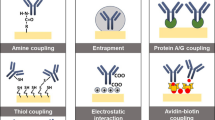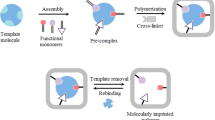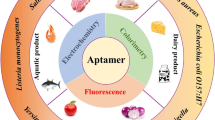Abstract
The two-dimensional porphyrin-based covalent organic framework (denoted by Tph-TDC-COF) was used as the sensitive layerto build an aptamer-based electrochemical sensor for the detection of Escherichia coli (E.coli). Tph-TDC-COF produced with 5,10,15,20-tetrakis(4-aminophenyl)-21H, 23H-porphine (Tph) and [2,2′-bithiophene]-2,5′-dicarbaldehyde (TDC) as building blocks exhibited a highly conjugated structure, outstanding conductivity, large specific surface area, and strong bioaffinity towards aptamers. The adoption of Tph-TDC-COF-modified electrode resulted in improved sensing performance and increased anchoring affinity toward the E.coli-targeted aptamer. Under optimal conditions, the Tph-TDC-COF-based electrochemical aptasensor demonstrated an extremely low detection limit of 0.17 CFU mL−1 for E.coli detection within a linear range of 10 to 1 × 108 CFU mL−1, accompanied by good stability, excellent reproducibility and regeneration ability, and wide practical applications. The current electrochemical aptasensing technique has the potential to be extended to detect different foodborne bacteria using specific aptamer, therefore widening the application of COFs in biosensing and food safety fields.
Graphical abstract





Similar content being viewed by others
Data Availability
The authors confirm that the data supporting the findings of this study are available within the article and its supplementary materials.
References
Kiranmayi B, Mallika N (2010) Escherichia coli O157:H7 - an emerging pathogen in foods of animal origin. Vet World 3(9):382. https://doi.org/10.5455/vetworld.2010.382-389
Wang D, Chen J, Nugen SR (2017) Electrochemical detection of Escherichia coli from aqueous samples using engineered phages. Anal Chem 89:1650–1657. https://doi.org/10.1021/acs.analchem.6b03752
Bazsefidpar S, Serrano-Pertierra E, Gutiérrez G, Calvo AS, Matos M, Blanco-López MC (2023) Rapid and sensitive detection of E. coli O157:H7 by lateral flow immunoassay and silver enhancement. Microchim Acta 190:264. https://doi.org/10.1007/s00604-023-05834-8
Liu Y, Cao Y, Wang T, Dong Q, Li J, Niu C (2019) Detection of 12 common food-borne bacterial pathogens by TaqMan real-time PCR using a single set of reaction conditions. Front Microbiol 10:222. https://doi.org/10.3389/fmicb.2019.00222
Malekzad H, Jouyban A, Hasanzadeh M, Shadjou N, de la Guardia M (2017) Ensuring food safety using aptamer based assays: electroanalytical approach. TrAC, Trends Anal Chem 94:77–94. https://doi.org/10.1016/j.trac.2017.07.001
Ambaye AD, Kefeni KK, Mishra SB, Nxumalo EN, Ntsendwana B (2021) Recent developments in nanotechnology-based printing electrode systems for electrochemical sensors. Talanta 225:121951. https://doi.org/10.1016/j.talanta.2020.121951
Vidic J, Manzano M (2021) Electrochemical biosensors for rapid pathogen detection. Curr Opin Electrochem 29:100750. https://doi.org/10.1016/j.coelec.2021.100750
Zhang Z, Lou Y, Guo C, Jia Q, Song Y, Tian J-Y, Zhang S, Wang M, He L, Du M (2021) Metal–organic frameworks (MOFs) based chemosensors/biosensors for analysis of food contaminants. Trends Food Sci Technol 118:569–588. https://doi.org/10.1016/j.tifs.2021.10.024
Li Z, Zhang X, Qi H, Huang X, Shi J, Zou X (2022) A novel renewable electrochemical biosensor based on mussel-inspired adhesive protein for the detection of Escherichia coli O157:H7 in food. Sensors Actuators B Chem 372:132601. https://doi.org/10.1016/j.snb.2022.132601
Pourmadadi M, Shayeh JS, Omidi M, Yazdian F, Alebouyeh M, Tayebi L (2019) A glassy carbon electrode modified with reduced graphene oxide and gold nanoparticles for electrochemical aptasensing of lipopolysaccharides from Escherichia coli bacteria. Microchim Acta 186:787. https://doi.org/10.1007/s00604-019-3957-9
Qiao F-Y, Liu J, Li F-R, Kong X-L, Zhang H-L, Zhou H-X (2008) Antibody and DNA dual-labeled gold nanoparticles: stability and reactivity. Appl Surf Sci 254:2941–2946. https://doi.org/10.1016/j.apsusc.2007.10.046
Arul P, Huang S-T, Gowthaman NSK, Govindasamy M, Jeromiyas N (2020) Surfactant-free solvothermal synthesis of Cu-MOF via protonation-deprotonation approach: a morphological dependent electrocatalytic activity for therapeutic drugs. Microchim Acta 187:650. https://doi.org/10.1007/s00604-020-04631-x
Chinnapaiyan S, Tanaya Das H, Govindasamy M, Alothman AA, Ouladsmane M, Huang C-H (2022) Heterogeneous bimetallic (La–Fe) metal-organic-frameworks as an efficient bifunctional catalyst for high-performance supercapacitors and electrochemical sensors. J Electrochem Soc 169:106521. https://doi.org/10.1149/1945-7111/ac9b9a
Kou X, Tong L, Huang S, Chen G, Zhu F, Ouyang G (2021) Recent advances of covalent organic frameworks and their application in sample preparation of biological analysis. TrAC Trends Anal Chem 136:116182. https://doi.org/10.1016/j.trac.2021.116182
Zhao Y, Hao L, Ning J, Zhu H, Vijayakumar A, Wang C, Wallace GG (2021) A versatile transition metal ion-binding motif derived from covalent organic framework for efficient CO2 electroreduction. Appl Catal B Environ 291:119915. https://doi.org/10.1016/j.apcatb.2021.119915
Chinnapaiyan S, Rajaji U, Chen S-M, Liu T-Y, de Oliveira FJI, Chang Y-S (2022) Fabrication of thulium metal–organic frameworks based smartphone sensor towards arsenical feed additive drug detection: applicable in food safety analysis. Electrochim Acta 401:139487. https://doi.org/10.1016/j.electacta.2021.139487
Lahcen AA, Surya SG, Beduk T, Vijjapu MT, Lamaoui A, Durmus C, Timur S, Shekhah O, Mani V, Amine A, Eddaoudi M, Salama KN (2022) Metal–organic frameworks meet molecularly imprinted polymers: insights and prospects for sensor applications. ACS Appl Mater Interfaces 14:49399–49424. https://doi.org/10.1021/acsami.2c12842
Bhunia S, Deo KA, Gaharwar AK (2020) 2D covalent organic frameworks for biomedical applications. Adv Func Mater 30:2002046. https://doi.org/10.1002/adfm.202002046
Evans AM, Giri A, Sangwan VK, Xun S, Bartnof M, Torres-Castanedo CG, Balch HB, Rahn MS, Bradshaw NP, Vitaku E, Burke DW, Li H, Bedzyk MJ, Wang F, Brédas J-L, Malen JA, McGaughey AJH, Hersam MC, Dichtel WR, Hopkins PE (2021) Thermally conductive ultra-low-k dielectric layers based on two-dimensional covalent organic frameworks. Nat Mater 20:1142–1148. https://doi.org/10.1038/s41563-021-00934-3
Zhu B, Zhu L, Deng S, Wan Y, Qin F, Han H, Luo J (2023) A fully π-conjugated covalent organic framework with dual binding sites for ultrasensitive detection and removal of divalent heavy metal ions. J Hazard Mater 459:132081. https://doi.org/10.1016/j.jhazmat.2023.132081
Lin G, Ding H, Yuan D, Wang B, Wang C (2016) A pyrene-based, fluorescent three-dimensional covalent organic framework. J Am Chem Soc 138:3302–3305. https://doi.org/10.1021/jacs.6b00652
Das P, Mandal SK (2018) A dual-functionalized, luminescent and highly crystalline covalent organic framework: molecular decoding strategies for VOCs and ultrafast TNP sensing. J Mater Chem A 6:16246–16256. https://doi.org/10.1039/C8TA05070H
Singh H, Tomer VK, Jena N, Bala I, Sharma N, Nepak D, De Sarkar A, Kailasam K, Pal SK (2017) A porous, crystalline truxene-based covalent organic framework and its application in humidity sensing. J Mater Chem A 5:21820–21827. https://doi.org/10.1039/C7TA05043G
Chen L, He L, Ma F, Liu W, Wang Y, Silver MA, Chen L, Zhu L, Gui D, Diwu J, Chai Z, Wang S (2018) Covalent organic framework functionalized with 8-hydroxyquinoline as a dual-mode fluorescent and colorimetric pH sensor. ACS Appl Mater Interfaces 10:15364–15368. https://doi.org/10.1021/acsami.8b05484
Wang Y, Zhao Z, Li G, Yan Y, Hao C (2018) A 2D covalent organic framework as a sensor for detecting formaldehyde. J Mol Model 24:153. https://doi.org/10.1007/s00894-018-3676-x
Li W, Yang C-X, Yan X-P (2017) A versatile covalent organic framework-based platform for sensing biomolecules. Chem Commun 53:11469–11471. https://doi.org/10.1039/C7CC06244C
Huang S, Chen K, Li T-T (2022) Porphyrin and phthalocyanine based covalent organic frameworks for electrocatalysis. Coord Chem Rev 464:214563. https://doi.org/10.1016/j.ccr.2022.214563
Wang M, Hu M, Liu J, Guo C, Peng D, Jia Q, He L, Zhang Z, Du M (2019) Covalent organic framework-based electrochemical aptasensors for the ultrasensitive detection of antibiotics. Biosens Bioelectron 132:8–16. https://doi.org/10.1016/j.bios.2019.02.040
Wang K, Qi D, Li Y, Wang T, Liu H, Jiang J (2019) Tetrapyrrole macrocycle based conjugated two-dimensional mesoporous polymers and covalent organic frameworks: from synthesis to material applications. Coord Chem Rev 378:188–206. https://doi.org/10.1016/j.ccr.2017.08.023
Chen R, Kan L, Xu M, Zhang G, Wang M, Cui J, Zhou N, He L (2022) Impedimetric aptasensor based on porphyrin-based covalent-organic framework for determination of diethylstilbestrol. Microchim Acta 189:229. https://doi.org/10.1007/s00604-022-05310-9
Zhang X, Chi K-N, Li D-L, Deng Y, Ma Y-C, Xu Q-Q, Hu R, Yang Y-H (2019) 2D-porphrinic covalent organic framework-based aptasensor with enhanced photoelectrochemical response for the detection of C-reactive protein. Biosens Bioelectron 129:64–71. https://doi.org/10.1016/j.bios.2019.01.009
She P, Qin Y, Wang X, Zhang Q (2022) Recent progress in external-stimulus-responsive 2D covalent organic frameworks. Adv Mater 34:2101175. https://doi.org/10.1002/adma.202101175
Yan X, Song Y, Liu J, Zhou N, Zhang C, He L, Zhang Z, Liu Z (2019) Two-dimensional porphyrin-based covalent organic framework: a novel platform for sensitive epidermal growth factor receptor and living cancer cell detection. Biosens Bioelectron 126:734–742. https://doi.org/10.1016/j.bios.2018.11.047
Cui J, Kan L, Cheng F, Liu J, He L, Xue Y, Fang S, Zhang Z (2022) Construction of bifunctional electrochemical biosensors for the sensitive detection of the SARS-CoV-2 N-gene based on porphyrin porous organic polymers. Dalton Trans 51:2094–2104. https://doi.org/10.1039/D1DT03869A
Cui J, Wu B, Li Z, Bai Y, Kan L, Wang M, He L, Du M (2023) Hierarchical CoCoPBA@PCN-221 nanostructure for the highly sensitive detection of deoxynivalenol in foodstuffs. Food Chem 403:134370. https://doi.org/10.1016/j.foodchem.2022.134370
Xiong M, Wang B, Wang H, Xu F, Zeng Y, Ren H, Zeng H (2022) Probing the adsorption behavior and mechanism of NO2 and NH2 functionalized covalent organic frameworks (COFs) for removal of bisphenol A. Microporous Mesoporous Mater 346:112299. https://doi.org/10.1016/j.micromeso.2022.112299
Cui J, Kan L, Li Z, Yang L, Wang M, He L, Lou Y, Xue Y, Zhang Z (2021) Porphyrin-based covalent organic framework as bioplatfrom for detection of vascular endothelial growth factor 165 through fluorescence resonance energy transfer. Talanta 228:122060. https://doi.org/10.1016/j.talanta.2020.122060
Lohse MS, Stassin T, Naudin G, Wuttke S, Ameloot R, De Vos D, Medina DD, Bein T (2016) Sequential pore wall modification in a covalent organic framework for application in lactic acid adsorption. Chem Mater 28:626–631. https://doi.org/10.1021/acs.chemmater.5b04388
Peng Y, Huang Y, Zhu Y, Chen B, Wang L, Lai Z, Zhang Z, Zhao M, Tan C, Yang N, Shao F, Han Y, Zhang H (2017) Ultrathin two-dimensional covalent organic framework nanosheets: preparation and application in highly sensitive and selective DNA detection. J Am Chem Soc 139:8698–8704. https://doi.org/10.1021/jacs.7b04096
Xu M, Chen K, Zhu L, Zhang S, Wang M, He L, Zhang Z, Du M (2021) MOF@COF heterostructure hybrid for dual-mode photoelectrochemical–electrochemical HIV-1 DNA sensing. Langmuir 37:13479–13492. https://doi.org/10.1021/acs.langmuir.1c02253
Zhang X, Gao Y, Li J, Yan J, Liu P, Fan X, Song W (2023) A novel TAPP-DHTA COF cathodic photoelectrochemical immunosensor based on CRISPR/Cas12a-induced nanozyme catalytic generation of heterojunction. Electrochim Acta 441:141771. https://doi.org/10.1016/j.electacta.2022.141771
Ding S-Y, Dong M, Wang Y-W, Chen Y-T, Wang H-Z, Su C-Y, Wang W (2016) Thioether-based fluorescent covalent organic framework for selective detection and facile removal of mercury(II). J Am Chem Soc 138:3031–3037. https://doi.org/10.1021/jacs.5b10754
Zhang Y, Wang Q, Li Y, Hu R (2022) Bithiophene-based COFs for silver ions detection and removal. Microporous Mesoporous Mater 346:112289. https://doi.org/10.1016/j.micromeso.2022.112289
Liu X, Hu M, Wang M, Song Y, Zhou N, He L, Zhang Z (2019) Novel nanoarchitecture of Co-MOF-on-TPN-COF hybrid: Ultralowly sensitive bioplatform of electrochemical aptasensor toward ampicillin. Biosens Bioelectron 123:59–68. https://doi.org/10.1016/j.bios.2018.09.089
Gupta A, Garg M, Singh S, Deep A, Sharma AL (2020) Highly sensitive optical detection of Escherichia coli using terbium-based metal–organic framework. ACS Appl Mater Interfaces 12:48198–48205. https://doi.org/10.1021/acsami.0c14312
Zhang Y, Yang L, Wang H, Huang J, Lin Y, Chen S, Guan X, Yi M, Li S, Zhang L (2021) Bioinspired metal–organic frameworks mediated efficient delivery of siRNA for cancer therapy. Chem Eng J 426:131926. https://doi.org/10.1016/j.cej.2021.131926
Adachi T, Nakamura Y (2019) Aptamers: a review of their chemical properties and modifications for therapeutic application. Molecules 24:4229. https://doi.org/10.3390/molecules24234229
Guo W, Sun N, Qin X, Pei M, Wang L (2015) A novel electrochemical aptasensor for ultrasensitive detection of kanamycin based on MWCNTs–HMIMPF6 and nanoporous PtTi alloy. Biosens Bioelectron 74:691–697. https://doi.org/10.1016/j.bios.2015.06.081
Inam AKMS, Angeli MAC, Douaki A, Shkodra B, Lugli P, Petti L (2022) An aptasensor based on a flexible screen-printed silver electrode for the rapid detection of chlorpyrifos. Sensors 22:2754. https://doi.org/10.3390/s22072754
Hiremath SD, Bhosle AA, Nayse A, Biswas S, Biswas M, Bhasikuttan AC, Banerjee M, Chatterjee A (2021) A redox-coupled carbon dots-MnO2 nanosheets based sensory platform for label-free and sensitive detection of E. coli. Sensors Actuators B Chem 339:129918. https://doi.org/10.1016/j.snb.2021.129918
Wang B, Huang X, Ma M, Shi Q, Cai Z (2014) A simple quantum dot-based fluoroimmunoassay method for selective capturing and rapid detection of Salmonella Enteritidis on eggs. Food Control 35:26–32. https://doi.org/10.1016/j.foodcont.2013.06.025
Zhao W, Xing Y, Lin Y, Gao Y, Wu M, Xu J (2020) Monolayer graphene chemiresistive biosensor for rapid bacteria detection in a microchannel. Sens Actuators Rep 2:100004. https://doi.org/10.1016/j.snr.2020.100004
Díaz-Amaya S, Lin L-K, Deering AJ, Stanciu LA (2019) Aptamer-based SERS biosensor for whole cell analytical detection of E. coli O157:H7. Anal Chim Acta 1081:146–156. https://doi.org/10.1016/j.aca.2019.07.028
Wang P, Wang A, Hassan MM, Ouyang Q, Li H, Chen Q (2020) A highly sensitive upconversion nanoparticles-WS2 nanosheet sensing platform for Escherichia coli detection. Sensors Actuators B Chem 320:128434. https://doi.org/10.1016/j.snb.2020.128434
Jijie R, Kahlouche K, Barras A, Yamakawa N, Bouckaert J, Gharbi T, Szunerits S, Boukherroub R (2018) Reduced graphene oxide/polyethylenimine based immunosensor for the selective and sensitive electrochemical detection of uropathogenic Escherichia coli. Sens Actuators, B Chem 260:255–263. https://doi.org/10.1016/j.snb.2017.12.169
Zhong M, Yang L, Yang H, Cheng C, Deng W, Tan Y, Xie Q, Yao S (2019) An electrochemical immunobiosensor for ultrasensitive detection of Escherichia coli O157:H7 using CdS quantum dots-encapsulated metal-organic frameworks as signal-amplifying tags. Biosens Bioelectron 126:493–500. https://doi.org/10.1016/j.bios.2018.11.001
Funding
This work was supported by the National Natural Science Foundation of China (No. 51903224), the Excellent Youth Science Foundation (202300410494) and the Scientific and Technological Project (No. 222102220086) of Henan Province, China.
Author information
Authors and Affiliations
Corresponding authors
Ethics declarations
Conflict of interest
The authors declare no competing interests.
Additional information
Publisher's Note
Springer Nature remains neutral with regard to jurisdictional claims in published maps and institutional affiliations.
Supplementary Information
Below is the link to the electronic supplementary material.
Rights and permissions
Springer Nature or its licensor (e.g. a society or other partner) holds exclusive rights to this article under a publishing agreement with the author(s) or other rightsholder(s); author self-archiving of the accepted manuscript version of this article is solely governed by the terms of such publishing agreement and applicable law.
About this article
Cite this article
Cui, J., Zhang, Y., Lun, K. et al. Sensitive detection of Escherichia coli in diverse foodstuffs by electrochemical aptasensor based on 2D porphyrin-based COF. Microchim Acta 190, 421 (2023). https://doi.org/10.1007/s00604-023-05978-7
Received:
Accepted:
Published:
DOI: https://doi.org/10.1007/s00604-023-05978-7




